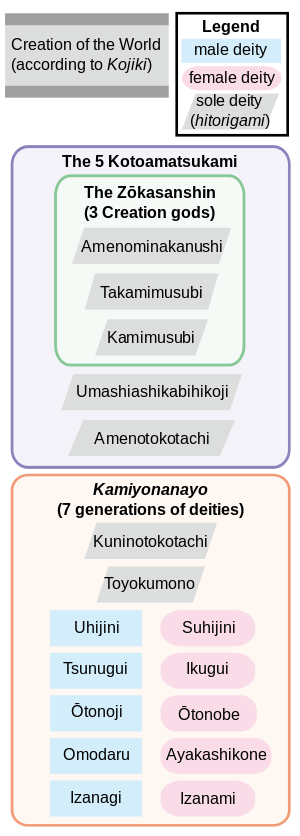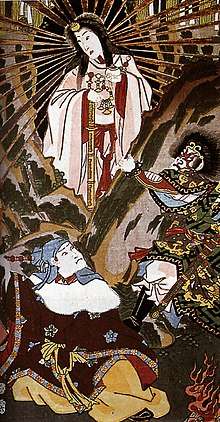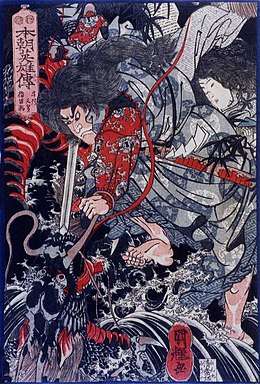Kamiyonanayo
In Japanese mythology, the Kamiyo-nanayo (神世七代, lit. "Seven Generations of the Age of the Gods") are the seven generations of kami that emerged after the formation of heaven and earth.[1]

According to the Kojiki, these deities appeared after the Kotoamatsukami. The first two generations were hitorigami while the five that followed came into being as male-female pairs of kami: male deities and sisters that were at the same time married couples. In total the Kamiyonanayo consist of 12 deities in this chronicle.[1]
In contrast, the chronicle Nihon Shoki, points out that this group was the first to appear after the creation of the universe. It also states that the first three generations of deities were hitorigami and that the other generations of deities were pairs of the opposite sex. Finally the Nihon Shoki uses a different spelling for the names of all deities.
The last generation formed by Izanagi and Izanami were the couple that would be responsible for the creation of the Japanese archipelago (Kuniumi) and would engender other deities (Kamiumi).[2][3]
List of deities
| Gen. | Name according to Kojiki (Honorific form) | Name according to Nihonshoki
(Honorific form) |
|---|---|---|
| 1 | Kuninotokotachi (国之常立神, Kuninotokotachi-no-kami) | Kuninotokotachi (国常立尊, Kuninotokotachi-no-mikoto)/ Kuni-no-satsuchi (国狭槌尊, Kuni-no-satsuchi-no-mikoto) |
| 2 | Toyo-kumono-no-kami (豊雲野神, Toyo-kumo-no-no-kami) | Toyokumunu (豊斟渟尊, Toyokumunu-no-mikoto; 豊組野尊, Toyokumuno-no-mikoto; 豊香節野尊, Toyokabuno-no-mikoto; 浮経野豊買尊, Ukabuno-no-toyokafu-no-mikoto; 豊国野尊, Toyokunino-no-mikoto; 豊齧野尊, Toyokabuno-no-mikoto; 葉木国野尊, Hakokunino-no-mikoto; 見野尊, Mino-no-mikoto) |
| 3 | Uhijini (宇比邇神, Uhijini-no-kami) and Suhijini (須比智邇神, Suhijini-no-kami) | Uhijini (泥土煮尊, Uhijini-no-mikoto) and Suhijini (沙土煮尊, Suhijini-no-mikoto) |
| 4 | Tsunuguhi (角杙神 Tsunuguhi-no-kami) and Ikuguhi (活杙神, Ikuguhi-no-kami) | Tsunuguhi (角樴尊, Tsunuguhi-no-mikoto) and Ikuguhi (活樴尊, Ikuguhi-no-Mikoto) |
| 5 | Ōtonoji (意富斗能地神) and Ōtonobe (大斗乃弁神) | Ōtonoji (大戸之道尊, Ōtonoji-no-mikoto; 大戸摩彦尊, Ōtoma-hiko-no-mikoto; 大富道尊, Ōtomuji-no-mikoto) and Ōtomabe (大苫辺尊, Ōtomabe-no-mikoto) |
| 6 | Omodaru (淤母陀琉神, Omodaru-no-kami) and Aya-kashiko-ne (阿夜訶志古泥神, Aya-kashiko-ne-no-kami) | Omodaru (面足尊, Omodaru-no-mikoto) and Kashiko-ne (惶根尊, Kashiko-ne-no-mikoto) |
| 7 | Izanagi (伊邪那岐神, Izanagi-no-kami) and Izanami (伊邪那美神, Izanami-no-kami) | Izanagi (伊弉諾尊, Izanagi-no-mikoto) and Izanami (伊弉冉尊, Izanami-no-mikoto) |
See also
References
- Chamberlain 2008, p. 72
- Chamberlain 2008, p. 75
- Chamberlain 2008, p. 77
Bibliography
- Chamberlain, Basil Hall (2008). The Kojiki: Japanese Records of Ancient Matters. Forgotten Books. ISBN 978-1-60506-938-8. Retrieved 9 February 2011.
- "Génesis del mundo y aparición de los primeros dioses" [Genesis of the world and appearance of the first gods] (PDF) (in Spanish). Archived from the original (PDF) on 2007-11-10.

